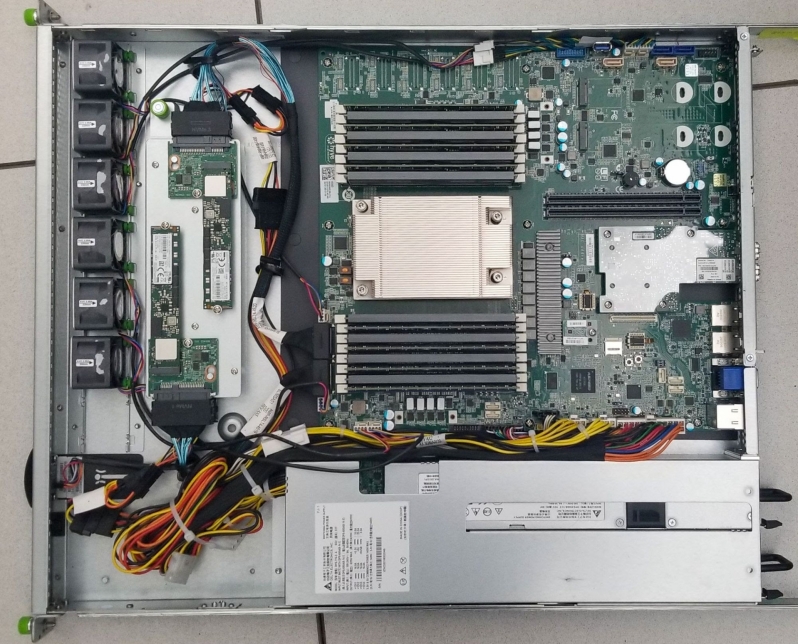Cloudflare backs AMD with its Gen 11 servers as Intel’s Ice Lake chips consume “several hundred watts” more
Cloudflare backs AMD with its Gen 11 servers as Intel’s Ice Lake chips consume “several hundred watts” more
With their latest Gen 11 x86 Edge servers, Cloudflare has reported that each of their new servers can serve approximately 29% more requests than their last-generation counterparts without consuming any additional power. This allows Cloudflare’s new servers to do more work without increasing the company’s power bill, which is a big deal for the company.Â
With their Gen 11 servers, Cloudflare will be moving from AMD’s 2nd Generation EPYC “Rome” 7642 48-core processor to AMD’s new 3rd Generation EPYC “Milan” 7713 64-core processor. Additionally, Cloudflare will move from 256GB of 2933MHz DDR4 memory to 384GB of 3200MHz DDR4 memory and use a faster NVMe storage solution.
As a whole, Cloudflare’s Gen 11 servers are evolutionary, not revolutionary. Even so, these new servers will be able to do more work than their predecessors and not shoot the company’s power bill through the roof.Â
Intel’s Ice Lake Xeon processors consumer “several hundred watts higher per server”
Cloudflare has stated that they did look at Intel’s Ice Lake Xeon processors when designing their Gen 11 servers, and while Cloudflare was able to compete with AMD in terms of raw performance, Intel’s CPUs consumed more power than their AMD counterparts.Â
Compared to AMD’s EPYC offerings, Cloudflare stated that Intel’s CPU consumed “several hundred watts” more than AMD’s CPUs on a per-server basis. When operating servers at high load 24/7, power costs quickly add up, making AMD’s 3rd Generation EPYC processors more attractive for their workloads. Beyond that, higher power draw results in additional heat production, adding the cost of cooling your data centre.Â
While this is a clear win for AMD’s EPYC lineup, Cloudflare has stated that they are looking forward to seeing how Intel’s next-generation CPUs shape up. While Intel did not meet Cloudflare’s requirements this time, Cloudflare is looking forward to seeing what’s coming next from the blue team.Â
  We continually work with our silicon vendors to receive product roadmaps and stay on top of the latest technologies. Since mid-2020, the hardware engineering team at Cloudflare has been working on our generation 11 server.
Requests per Watt is one of our defining characteristics when testing new hardware and we use it to identify how much more efficient a new hardware generation is than the previous generation. We continually strive to reduce our operational costs and power consumption reduction is one of the most important parts of this. It’s good for the planet and we can fit more servers into a rack, reducing our physical footprint.
The design of these Generation 11 x86 servers has been in parallel with our efforts to design next-generation edge servers using the Ampere Altra ARM architecture. You can read more about our tests in a blog post by my colleague Sung and will document our work on Arm at the edge in a subsequent blog post.
We evaluated Intel’s latest generation of “Ice Lake†Xeon processors. Although Intel’s chips were able to compete with AMD in terms of raw performance, the power consumption was several hundred watts higher per server – that’s enormous. This meant that Intel’s Performance per Watt was unattractive.
We previously described how we had deployed AMD EPYC 7642’s processors in our generation 10 server. This has 48 cores and is based on AMD’s 2nd generation EPYC architecture, code named Rome. For our generation 11 server, we evaluated 48, 56 and 64 core samples based on AMD’s 3rd generation EPYC architecture, code named Milan. We were interested to find that comparing the two 48 core processors directly, we saw a performance boost of several percent in the 3rd generation EPYC architecture. We therefore had high hopes for the 56 core and 64 core chips.
So, based on the samples we received from our vendors and our subsequent testing, hardware from AMD and Ampere made the shortlist for our generation 11 server. On this occasion, we decided that Intel did not meet our requirements. However, it’s healthy that Intel and AMD compete and innovate in the x86 space and we look forward to seeing how Intel’s next generation shapes up.
You can join the discussion on Cloudflare Gen 11 Edge servers on the OC3D Forums.Â





